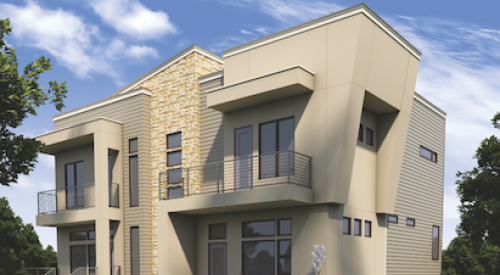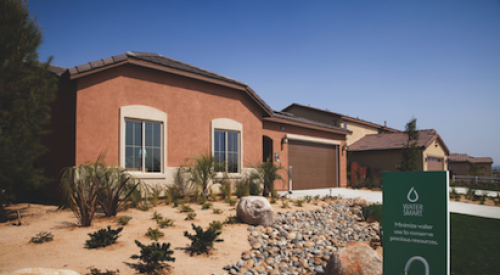|
With apologies to John Mayer, Charlie Kamps isn’t waiting for the world to change. He’s forging ahead with an ambitious project that will put affordable, sustainable homes within the reach of large numbers of Americans — and could also change the way homes are built and delivered to the marketplace.
| THE STARTER HOME is designed for singles and couples. The 16-foot-wide model is shown with a Traditional elevation. All renderings courtesy of BartonPartners Architects Planners |
Kamps is the visionary behind the American Sustainability Initiative (AmeriSus), a consortium of nationally recognized companies such as CertainTeed, Shaw, ProBuild, Whirlpool, Federal Express and IKEA. BartonPartners Architects Planners in Norristown, Pa., is supplying the designs. The concept is reminiscent of the Sears mail-order homes of the early 20th century: pre-designed, pre-engineered homes in kit form, delivered to the job site for assembly. By the end of next year, AmeriSus hopes to sell 12,000 new homes. The initial offering will be available in 15 states from the Mid-Atlantic through the central Midwest. By 2011, AmeriSus expects to be delivering homes throughout the continental United States.
What’s different about AmeriSus is that developers, builders (and eventually home buyers) will order the components online and they’ll be delivered sequentially. Synchronized flow, also known as just-in-time delivery, allows for rapid assembly without many of the redundant tasks, waste and inefficiency of conventional construction processes.
Another difference is that the homes utilize energy-efficient building practices that encompass the building envelope, HVAC system, appliances and lighting. AmeriSus homes can either be certified by LEED or the NAHB National Green Building Program. With sales prices ranging from $200,000 to $260,000 (depending on square footage and including land), they’re also affordable.
“Our agenda has been, from day one, to put in place homes that the average person can afford to buy and own without long-term damage to the household budget,” says Kamps. “Because they’re smaller, they’re super-efficient and simple to put together.”
| THE 24-FOOT-WIDE Family model has three bedrooms, 21⁄2 baths and an open main level with kitchen, great room and laundry room. |
In addition to being the managing director of AmeriSus, Kamps is a builder and developer who owns a company called Transactionable Property Solutions (TPS), based in Penns Park, Pa. TPS specializes in brownfields and distressed, impaired and underutilized properties. “Early on it was probably more commercial and retail, but in the last eight to 10 years a large part of it has been residential and mixed-use,” he says. Before he started TPS, Kamps spent years building chemical plants and refineries around the world. He is an industrial engineer by education.
That engineering experience was put to good use as Kamps and his team began formulating the AmeriSus concept two years ago. “We asked ourselves, 'How can we cut out the waste in materials and labor and time, and reinvest it back into the house so that we end up with something that has higher quality and better value?’”
The AmeriSus team looked at every step in the home-building process, questioning why and how it was done. Then they developed the Ready Build System™, a proprietary, computerized online building tool that takes the 2,000-plus parts of a house, puts them in order of assembly, allows for product/material selection and brings national logistics and pricing to builders around the country.
| THE 16-FOOT STARTER HOME (plans above) packs a lot into a narrow footprint: home office on the first floor, front and rear entrances and two bedrooms upstairs. |
Here’s how it works: Builders select the home they want and configure styles and options. Land, site improvements and infrastructure become builder add-ons. Once the model, design and options are selected, basic pricing is set. After permits and builder financing are in place, the system automatically orders all the components needed for the selected design package, and suppliers fill the orders and sequentially ship materials to the job site. Federal Express is the AmeriSus logistics partner that gets the right parts to the right job on time, every day.
Kamps says the utility bill for an AmeriSus home is 30 percent that of a comparably priced, conventionally built home, and the very affordable energy options will create the largest installed base of net-zero-energy homes nationwide. The homes are built with prefabricated, structural insulated panels (SIPs), air and moisture barriers, high-efficiency windows and air-lock vestibules at front and rear doors. High-efficiency HVAC systems are zoned for comfort and utilize new advances in heating and cooling technology. Other features include natural materials, low-VOC paints and sealants, Energy Star appliances and lighting fixtures, and high-efficiency hot water systems. Home buyers can add such options as roof-mounted solar panels and radiant floor heating as well as an Apple-managed home automation/computing system.
Another AmeriSus partner, Wells Fargo, is offering green mortgages, savings and investment accounts and discounted auto, life and homeowners insurance. IKEA will supply cabinets and other kitchen components, as well as wardrobe units. Whirlpool is offering a full line of Energy Star products, including laundry, cooking, refrigeration and dishwashers, says Mitchell Isert, director of Whirlpool’s North Atlantic contract division. The appliances will be delivered just before the house closes. “We’re very excited about the AmeriSus concept — how they’re going to go to market with it and work with our brands and products from a green perspective,” Isert says. “It’s a visionary process that will be great for the industry.”
| Compared to traditional home-building methods, the AmeriSus system cuts construction costs and saves time while maximizing energy efficiency, quality, value and profit for the builder.Source: American Sustainability Initiative |
Kamps sees yet another way in which the initiative will benefit Americans. “Every time you build a house you’re putting 50 people to work — plumbers, electricians, carpenters, framers ... all local people. If we can achieve a major portion of our goal, my numbers show it equates to putting about 200,000 people to work, split about half and half between construction sites and the factories that make the washing machines, shingles, doors — everything including the kitchen sink.”
According to AmeriSus calculations (which are third-party verified), total builder costs are reduced by 5 to 10 percent and the schedule is cut nearly in half. Builders can achieve a return that is twice that of a traditionally built project. “To be more specific, where a builder is experiencing an 8 percent return he can now experience a 17 to 19 percent return,” says Kamps, emphasizing that these numbers don’t include land or site development. For example, on a 100-unit development, a builder could save $1 million to $2 million, “which all goes directly to the bottom line.”
Another benefit is that many upfront costs (such as architectural and engineering) are spread out over the life of the build cycle, further lessening the burden a builder incurs early on in a project. “Unlike typical homes with architectural and construction drawings, we’re providing something that is probably four times as detailed and literally becomes an assembly manual,” says Kamps.
| A residential neighborhood filled with single-family Amerisus homes might look something like this. |
Of course, the 500-pound gorilla in the room is construction financing, but Kamps isn’t letting this obstacle slow him down. “I believe there’s going to be a change in the way the government interacts with the banking system, and that there will be a freeing up of money to help create real jobs,” he says. “For the very near term, I think we’re going to see smaller-scale projects going forward in areas where there’s local private investment.” The design portfolio
The AmeriSus portfolio currently consists of 20 different designs, including Starter, Family and EasyLiving homes. Starter and EasyLiving homes are available in 16- and 24-foot widths; Family homes are offered in 14-, 16- and 24-foot widths. Square footages range from 1,100 to 1,800. EasyLiving homes have first-floor master suites and can meet accessibility requirements when built slab-on-grade. All are offered with a choice of three elevations — Contemporary, Modern and Traditional — in slab, crawl-space or full-basement configurations. The Family model is currently the only one available for configuration as a 14-foot townhome.
Excluding labor, the 24-foot Family model costs about $40 per square foot in materials, says Tom Barton, principal of BartonPartners. “That’s about the same as conventional construction,” Barton says. “Another way to look at it is that the price of materials for that house is about $60,000, including all fees, architectural drawings and permit drawings — everything above the foundation.”
| AmeriSus homes can be configured as 14-foot-wide infill townhomes. The Modern elevation is shown. |
Builders of any size can use the system. “You buy the houses one at a time, whether you’re a big builder or a small builder. There is some volume discount potential [for large builders].” Barton says there has been a lot of interest in AmeriSus from community development corporations (CDCs), housing authorities and similar groups that are doing scattered-lot projects or have an inventory of developed lots. “AmeriSus makes it easier for them to move from lot to lot and just put down these prototypes,” he says.
Case in point: Lomax Real Estate Partners of Chalfont, Pa., plans to build 25 AmeriSus townhomes in Philadelphia. At press time, President and CEO Charles Lomax was still working with the city to assemble and entitle the land. “The biggest impediment right now is the market,” says Lomax. “But the size and style of the homes is exactly what it needs to be. If [AmeriSus] can bring it all together, it will make an antiquated system a lot more efficient.”
In addition to the Lomax project, AmeriSus has approximately 300 homes ready to build in four or five different states. Because of the high level of interest from states not on the original target list, “We’ve modified our approach to make it available to those other states on a project-by-project basis this year,” Kamps says.
|











